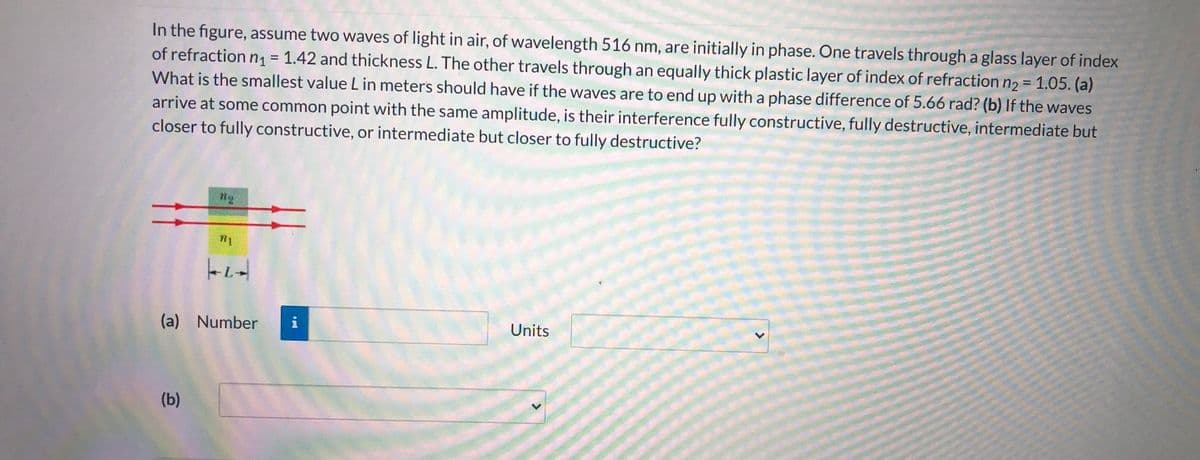In the figure, assume two waves of light in air, of wavelength 516 nm, are initially in phase. One travels through a glass layer of index of refraction n, = 1.42 and thickness L. The other travels through an equally thick plastic layer of index of refraction n2 = 1.05. (a) What is the smallest value L in meters should have if the waves are to end up with a phase difference of 5.66 rad? (b) If the waves arrive at some common point with the same amplitude, is their interference fully constructive, fully destructive, intermediate but closer to fully constructive, or intermediate but closer to fully destructive? (a) Number i Units (b)
In the figure, assume two waves of light in air, of wavelength 516 nm, are initially in phase. One travels through a glass layer of index of refraction n, = 1.42 and thickness L. The other travels through an equally thick plastic layer of index of refraction n2 = 1.05. (a) What is the smallest value L in meters should have if the waves are to end up with a phase difference of 5.66 rad? (b) If the waves arrive at some common point with the same amplitude, is their interference fully constructive, fully destructive, intermediate but closer to fully constructive, or intermediate but closer to fully destructive? (a) Number i Units (b)
Physics for Scientists and Engineers: Foundations and Connections
1st Edition
ISBN:9781133939146
Author:Katz, Debora M.
Publisher:Katz, Debora M.
Chapter38: Refraction And Images Formed By Refraction
Section: Chapter Questions
Problem 127PQ: Light enters a prism of crown glass and refracts at an angle of 5.00 with respect to the normal at...
Related questions
Question
please type the answer instead of hand writing

Transcribed Image Text:In the figure, assume two waves of light in air, of wavelength 516 nm, are initially in phase. One travels through a glass layer of index
of refraction n1 = 1.42 and thickness L. The other travels through an equally thick plastic layer of index of refraction n2 = 1.05. (a)
What is the smallest value L in meters should have if the waves are to end up with a phase difference of 5.66 rad? (b) If the waves
arrive at some common point with the same amplitude, is their interference fully constructive, fully destructive, intermediate but
closer to fully constructive, or intermediate but closer to fully destructive?
%3D
ng
(a) Number
i
Units
(b)
<>
Expert Solution
This question has been solved!
Explore an expertly crafted, step-by-step solution for a thorough understanding of key concepts.
This is a popular solution!
Trending now
This is a popular solution!
Step by step
Solved in 3 steps with 5 images

Knowledge Booster
Learn more about
Need a deep-dive on the concept behind this application? Look no further. Learn more about this topic, physics and related others by exploring similar questions and additional content below.Recommended textbooks for you

Physics for Scientists and Engineers: Foundations…
Physics
ISBN:
9781133939146
Author:
Katz, Debora M.
Publisher:
Cengage Learning

Principles of Physics: A Calculus-Based Text
Physics
ISBN:
9781133104261
Author:
Raymond A. Serway, John W. Jewett
Publisher:
Cengage Learning

University Physics Volume 3
Physics
ISBN:
9781938168185
Author:
William Moebs, Jeff Sanny
Publisher:
OpenStax

Physics for Scientists and Engineers: Foundations…
Physics
ISBN:
9781133939146
Author:
Katz, Debora M.
Publisher:
Cengage Learning

Principles of Physics: A Calculus-Based Text
Physics
ISBN:
9781133104261
Author:
Raymond A. Serway, John W. Jewett
Publisher:
Cengage Learning

University Physics Volume 3
Physics
ISBN:
9781938168185
Author:
William Moebs, Jeff Sanny
Publisher:
OpenStax